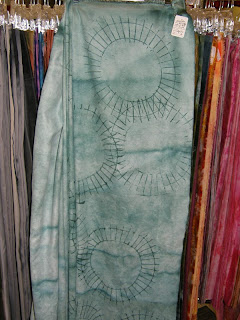Hi all – discussion of polyester comes up on the DyersList from time to time, so I thought I’d gather together the recent entries here. Plus it’s a chance to include some photos of my fabrics! Hover over the photo for a description.
In the books I have in my stash, there are three references to dyeing polyester:
- Brackmann, Holly ‘The Surface Designer’s Handbook’ – chapter 7
- Dahl, Carolyn ‘Transforming Fabric’ – chapter 8
- Proctor, Richard M, and Jennifer Lew ‘Surface Design for Fabric’ – page 42 - 43

Caryl Hancock also posted to the DyersList and kindly allowed me quote her:
I have two more sources for information on disperse dyes: the first is a book by Linda Kemshall, "Color Moves, Transfer Paints on Fabric" published by That Patchwork Place (Martingale?), C. 2001. Explains a lot of the ways to "play" with these dyes. (http://www.amazon.com/Color-Moves-Transfer-Paints-Fabric/dp/1564773418/ref=sr_1_2?s=books&ie=UTF8&qid=1290198560&sr=1-2) Under $10.Thanks, Caryl!

The second is a booklet by Jan Beaney and Jean Littlejohn, "Transfer to Transform." This is one of their earlier booklets (about 20 pages, I think) and is available from Quilting Arts or Amazon $16-21. There is nothing in the notes from the 2 classes I have had with Lisa [Grey] about other reference books; she probably knows the most of just about anyone about these dyes, and is a great teacher.
I also saw that there is a disperse dye class being offered at the SDA conference in Minneapolis next June.I have also purchased some of the colors from ALJO (http://www.aljodye.com/main.html) that are different from what Pro-Chem offers - no affiliation.
I use disperse dyes in printers. I buy them from Sawgrass. Sawgrass Inks also has a textile ink that prints from epson printers - the 4000 series prints 17" wide. http://www.sawgrassink.com/ they sell both desk size and large format printers, equipment and supplies. Conde Systems is another good supplier.
Jaquard also has dyes filtered very fine for printers. since they are acid and reactive dyes they need to be steamed - whereas textile pigments do not. disperse dyes need a heat set but not necessarily steam.there is a lot of information out on disperse dyes in printing presses. I mentioned sawgrassink before in another reply, and conde systems. They are also known as sublimation inks to printers. If you google sublimation inks you will find quite a bit.
Thank you too, Donna!

And Nancy Evans came up with another reference -
Below is a cut and paste from Pro Chemical’s Product Instructions page.
Imagery on Fabric by Jean Ray Laury also has a section on disperse dyes as well as transfer papers (which is just paper that is coated with disperse dye). A couple of times, I've lucked into acquiring some transfer papers, and they are fun to play with - got them at a thrift shop and a fabric store that holds onto everything it ever carried - nothing is clearanced! My good fortune to find them. I find the transfer papers are much more intense than the papers I paint with the disperse dye. Might be a function of how I've mixed? I do try to follow directions tho.... so maybe the papers are just brighter. ---nanThanks to you too, Nan!
I have learned a lot from Lisa Grey through a few emails and a phone call. Here’s a link to her class description: http://www.lisagrey.com/Lisa_Grey/Printing_DD.html - be sure to click on the “student work” link at the bottom.PRO Disperse Dyes Designed to permanently dye synthetic fibers -- in particular polyester, acetate rayon, nylon, and acrylic. Solid shade dyeing is done at a boil. A swelling agent, PRO Dye Carrier NSC, is necessary for the dye to penetrate polyester fiber.** Acrylic fibers do not dye dark; expect to achieve a pastel depth of shade only. Two ounces (58 gm) of dye powder will dye 25 lbs (11 kilograms) of polyester to a medium shade in a solid shade dye bath. Available in 13 intermixable colors. Note: many polyester and polyester-cotton fabrics have a permanent press finish. This must be removed before successful dyeing is achieved.
Transperse Transfer Printing Dyes - Your best choice for transfer printing on polyester and poly blends. Available in 9 intermixable colors.
And don't miss the work of Barbara Barrick McKie at http://www.mckieart.com/!
>
**I have never done any of my polyester this way. It is all direct application of dyes, either regular or thickened, allowed to dry and heat pressed. The thickened dye is more frugal – all the color is on the ‘right’ side (important with NuSuede), with the back remaining white. I also don’t do heat transfers, because I do 3 – 4 yard pieces and want fairly consistent results. Have yet to do any screen printing – I’ve never gotten into that.














2 comments:
Great results! Love that sunprint. Thanks for sharing your photos and resources.
Dear Lisa,
A million years ago, when I was a grad student in theatre costuming, I became the dept. dyer. Using only Rit dyes and a steam-jacketed former Navy coffee cauldron, I dyed all kinds of fabrics, including polyester double knit and foam rubber. I was dyeing to match color swatches, and trying to get the fabric to be as evenly colored as possible, so my technique was the opposite of what hand-dyers do to produce mottled, varied colors. I got to know the color tendencies of Rit dyes very well on different fibers, and really developed an eye for analyzing colors. A very valuable experience!
Linda Laird
quiltlady@san.rr.com
Post a Comment